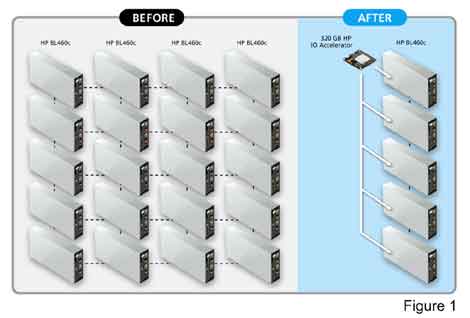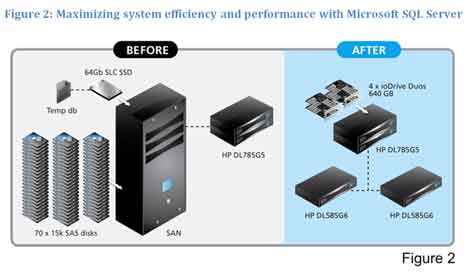Gary Orenstein is VP Products, Fusion-io.
 GARY ORENSTEIN
GARY ORENSTEINFusion-io
From 2005 to 2010, electricity usage at data centers worldwide increased by about 56 percent, accounting for more as much as two percent of all energy used in the U.S. 1 These figures are expected to increase as organizations implement new processes that generate more business critical data.
The Need for Performance and Consolidation
Modern computing workloads across database, virtualization and web applications require delivering the right data to the right user in the right amount of time - usually instantly. While classic disk drive-based architectures cannot keep up with this demand, flash memory has filled this gap, placing process critical data close to the CPU for dramatic performance gains.
But the performance flash provides is only half of the story. The other half is the infrastructure consolidation that happens when a single server can do the work of many. A key benefit to using less infrastructure is lower power consumption—one of the most pressing costs for data centers today.
Application and data center architects have an opportunity to address environmental challenges today with flash memory based solutions that significantly reduce server sprawl and power consumption. Let’s explore in more detail.
The Growing Issue in the Data Center
Performance and infrastructure-challenged systems typically manifest the following symptoms:
- Lengthy response times: Databases and applications take longer to respond to requests
- Limited number of connections per server: Only a fixed number of connections per server can be supported
- Disk drive sprawl: Solving IOPS challenges with disk drives means excessive numbers of disks, augmented by the associated SAN acquisition and implementation costs
- Server sprawl: For processing bottlenecks that cannot access data quickly enough, the result is often the purchase of numerous servers
Case Studies of Flash Usage
Both large and small companies may see benefits from deploying flash memory in the data center, as shown in the following examples.
A leading consumer question-and-answer website faced challenges keeping MySQL query response time low and maintaining replication for availability. Without flash memory, servers reached around 350 queries per second. Comparatively, a flash-enabled server could run 3,500 queries per second. This enabled a server reduction from 20 to 5 servers. Improving queries by ten times reduced the application’s average response time by 30 percent, a direct benefit to end-user engagement.
A credit reference agency's SAN-backed system averaged 6,000 to 7,000 IOPS running batch processes and never broke 7,500 IOPS. The batch process on the flash enabled system sustains over 16,000 IOPS with peaks in excess of 25,000 to 35,000 IOPS. Realizing that I/O was no longer a bottleneck, optimizations on the 80 core CPU system improved sustained performance to 23,000 IOPS and peak performance to 46,000 IOPS. This eliminated reliance on a 70 disk SAN that could be re-purposed.
A prominent Japanese e-commerce retailer faced data center space and power restrictions. Search demands were driving excessive disk and server scale out. Transitioning to a flash centric architecture allowed the company to:
- Fit in 50% less rack space by eliminating disks from servers, replacing a few hundred 2U servers with 5% fewer 1U servers
- Replaced power-hungry disk arrays with power-efficient, low-heat NAND flash
- Reduced maintenance and improved reliability with 70% fewer disks
Infrastructure Efficiency Opens New Business Opportunity
For years, organizations have faced such significant challenges just keeping up with performance, they have adopted a mind-set of saving money. While saving money is a big part of the business picture, making money is even more important. Better infrastructure efficiency, created by reducing energy and associated costs, helps businesses explore new market opportunities that were not previously available.
Today, more and more companies are not only reclaiming budget, they are also looking at re-purposing budgets to build new applications and serve new markets with flash-based solutions in ways previously not possible.
Industry Perspectives is a content channel at Data Center Knowledge highlighting thought leadership in the data center arena. See our guidelines and submission process for information on participating. View previously published Industry Perspectives in our Knowledge Library.
--
Notes:
All images courtesy Fusion-io.
(1) Koomey, Jonathan. 2011. Growth in Data center electricity use 2005 to 2010. http://www.analyticspress.com/datacenters.html>

 Click to enlarge image.
Click to enlarge image. Click to enlarge image.
Click to enlarge image. Click to enlarge image.
Click to enlarge image.


